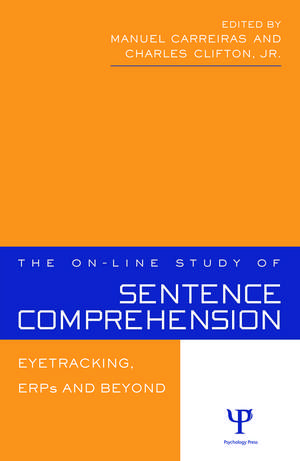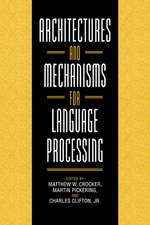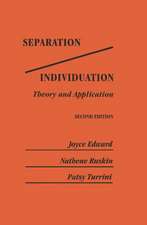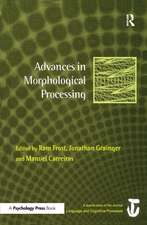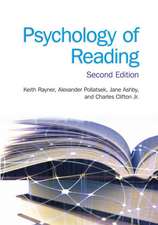The On-line Study of Sentence Comprehension: Eyetracking, ERPs and Beyond
Autor Manuel Carreiras, Charles Clifton, Jr.en Limba Engleză Paperback – 29 ian 2013
| Toate formatele și edițiile | Preț | Express |
|---|---|---|
| Paperback (1) | 473.03 lei 43-57 zile | |
| Taylor & Francis – 29 ian 2013 | 473.03 lei 43-57 zile | |
| Hardback (1) | 1178.48 lei 43-57 zile | |
| Taylor & Francis – 26 iul 2004 | 1178.48 lei 43-57 zile |
Preț: 473.03 lei
Preț vechi: 497.92 lei
-5% Nou
Puncte Express: 710
Preț estimativ în valută:
90.51€ • 94.76$ • 74.89£
90.51€ • 94.76$ • 74.89£
Carte tipărită la comandă
Livrare economică 07-21 aprilie
Preluare comenzi: 021 569.72.76
Specificații
ISBN-13: 9780415655781
ISBN-10: 0415655781
Pagini: 424
Ilustrații: 82 b/w images and 13 tables
Dimensiuni: 152 x 229 x 22 mm
Greutate: 0.66 kg
Ediția:1
Editura: Taylor & Francis
Colecția Psychology Press
Locul publicării:Oxford, United Kingdom
ISBN-10: 0415655781
Pagini: 424
Ilustrații: 82 b/w images and 13 tables
Dimensiuni: 152 x 229 x 22 mm
Greutate: 0.66 kg
Ediția:1
Editura: Taylor & Francis
Colecția Psychology Press
Locul publicării:Oxford, United Kingdom
Cuprins
M. Carreiras, C. Clifton, Jr., On the On-line Study of Language Comprehension. D.C. Mitchell, On-line Methods in Language Processing: Introduction and Historical Review. M.J. Pickering, S. Frisson, B. McElree, M.J. Traxler, Eye Movements and Semantic Composition. J.E. Boland, Linking Eye Movements to Sentence Comprehension in Reading and Listening. S.A. McDonald, R.C. Shillcock, Lexical Predictability Effects on Eye Fixations During Reading. M. Betancort, E. Meseguer, M. Carreiras, The Empty Category PRO: Processing What Can't Be Seen. R.P.G. van Gompel, S.P. Liversedge, J. Pearson, Antecedent Typicality Effects in the Processing of Noun Phrase Anaphors. P.C. Gordon, C. Christine Camblin, T.Y. Swaab, On-line Measures of Coreferential Processing. A.J. Sanford, P. Sturt, L. Moxey, L. Morrow, C. Emmott, Production and Comprehension Measures in Assessing Plural Object Formation. C. Scheepers, M.W. Crocker, Constituent Order Priming from Reading to Listening: A Visual-world Study.
F. Huettig, G.T.M. Altmann, The Online Processing of Ambiguous and Unambiguous Words in Context: Evidence from Head-mounted Eye-tracking. S. Brown-Schmidt, D.K. Byron, M.K. Tanenhaus, That's Not It and It is Not That: Reference Resolution and Conceptual Composites. J.J.A. van Berkum, Sentence Comprehension in a Wider Discourse: Can We Use ERPs to Keep Track of Things? L. Osterhout, J. McLaughlin, A. Kim, R. Greenwald, K. Inoue, Sentences in the Brain: Event-related Potentials as Real-time Reflections of Sentence Comprehension and Language Learning. H. Barber, E. Salillas, M. Carreiras, Gender or Genders Agreement? M. Hoen, P.F. Dominey, Evidence for a Shared Mechanism in Linguistic and Non-linguistic Sequence Processing? ERP Recordings of Online Function- and Content-information Integration.
C.J. Fiebach, M. Schlesewsky, I.D. Bornkessel, A.D. Friederici, Distinct Neural Correlates of Legal and Illegal Word Order Variations in German: How can fMRI Inform Cognitive Models of Sentence Processing? M.K. Tanenhaus, On-line Sentence Processing: Past, Present and Future.
F. Huettig, G.T.M. Altmann, The Online Processing of Ambiguous and Unambiguous Words in Context: Evidence from Head-mounted Eye-tracking. S. Brown-Schmidt, D.K. Byron, M.K. Tanenhaus, That's Not It and It is Not That: Reference Resolution and Conceptual Composites. J.J.A. van Berkum, Sentence Comprehension in a Wider Discourse: Can We Use ERPs to Keep Track of Things? L. Osterhout, J. McLaughlin, A. Kim, R. Greenwald, K. Inoue, Sentences in the Brain: Event-related Potentials as Real-time Reflections of Sentence Comprehension and Language Learning. H. Barber, E. Salillas, M. Carreiras, Gender or Genders Agreement? M. Hoen, P.F. Dominey, Evidence for a Shared Mechanism in Linguistic and Non-linguistic Sequence Processing? ERP Recordings of Online Function- and Content-information Integration.
C.J. Fiebach, M. Schlesewsky, I.D. Bornkessel, A.D. Friederici, Distinct Neural Correlates of Legal and Illegal Word Order Variations in German: How can fMRI Inform Cognitive Models of Sentence Processing? M.K. Tanenhaus, On-line Sentence Processing: Past, Present and Future.
Recenzii
'During the past twenty years, there has been considerable interest in the use of eye movements and event-related potentials (ERPs) to study many issues regarding language processing. The reason for this is obvious: eye movements provide the best moment-by-moment indicator of processing activity, and ERPs provide an on-line representation of brain activity. The chapters in this volume provide examples of current research activity using these two techniques. As such, the volume would be a good addition to the library of anyone interested in moment-by-moment language processing.' - Keith Rayner, University of Massachusetts
'This volume, which emanates from the highly respected Architectures and Mechanisms for Language Processing conferences, describes a wide range of research on language comprehension using eye tracking, event-related potentials, and related techniques. These techniques have become increasingly important and widely applied in the last fifteen years and are certain to be at centre stage in the years to come. The list of contributors is highly distinguished, and the book is likely to become a 'must have' for anyone working in the general area of language comprehension.' - Alan Garnham, University of Sussex
'This volume is a very timely contribution to the field of psycholinguistics. An increased number of studies use advanced on-line methods like eye tracking and electrophysiological recordings to study the human language system in action. This volume offers a highly needed overview of the current state of the art in on-line measurements of sentence comprehension. In addition, the different chapters provide a very fine sample of central topics in language comprehension research.' - Peter Hagoort, F.C. Donders Centre for Cognitive Neuroimaging, Radboud University Nijmegen
'This volume is in the best sense timely. It has been expertly distilled from a recent conference dedicated to the latest research in psycholinguistics. The book focuses on the time course of comprehension processes and reports a mixture of eye tracking and electrophysiological studies, seasoned with an intriguing sample of brain imaging applications. These methodologies have now achieved a maturity and range of application that allow rich comparison and contrast with each other and with earlier reaction time and accuracy based measures. This collection is as close as we are likely to get to an 'on-line' sample of unfolding scientific thought in one of the most complex domains of human cognition.' - Merrill F. Garrett, The University of Arizona
'This volume, which emanates from the highly respected Architectures and Mechanisms for Language Processing conferences, describes a wide range of research on language comprehension using eye tracking, event-related potentials, and related techniques. These techniques have become increasingly important and widely applied in the last fifteen years and are certain to be at centre stage in the years to come. The list of contributors is highly distinguished, and the book is likely to become a 'must have' for anyone working in the general area of language comprehension.' - Alan Garnham, University of Sussex
'This volume is a very timely contribution to the field of psycholinguistics. An increased number of studies use advanced on-line methods like eye tracking and electrophysiological recordings to study the human language system in action. This volume offers a highly needed overview of the current state of the art in on-line measurements of sentence comprehension. In addition, the different chapters provide a very fine sample of central topics in language comprehension research.' - Peter Hagoort, F.C. Donders Centre for Cognitive Neuroimaging, Radboud University Nijmegen
'This volume is in the best sense timely. It has been expertly distilled from a recent conference dedicated to the latest research in psycholinguistics. The book focuses on the time course of comprehension processes and reports a mixture of eye tracking and electrophysiological studies, seasoned with an intriguing sample of brain imaging applications. These methodologies have now achieved a maturity and range of application that allow rich comparison and contrast with each other and with earlier reaction time and accuracy based measures. This collection is as close as we are likely to get to an 'on-line' sample of unfolding scientific thought in one of the most complex domains of human cognition.' - Merrill F. Garrett, The University of Arizona
Notă biografică
Manuel Carreiras, Charles Clifton Jr.
